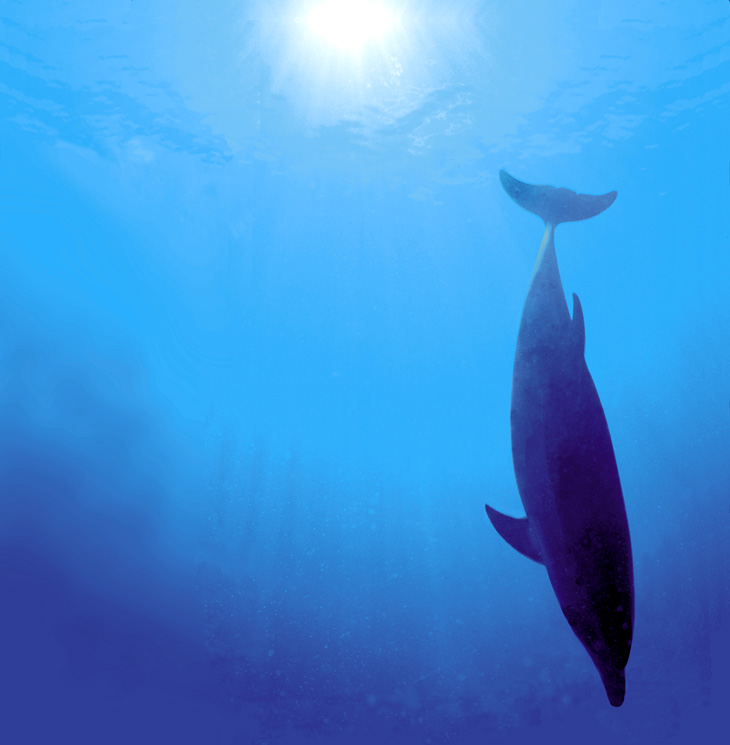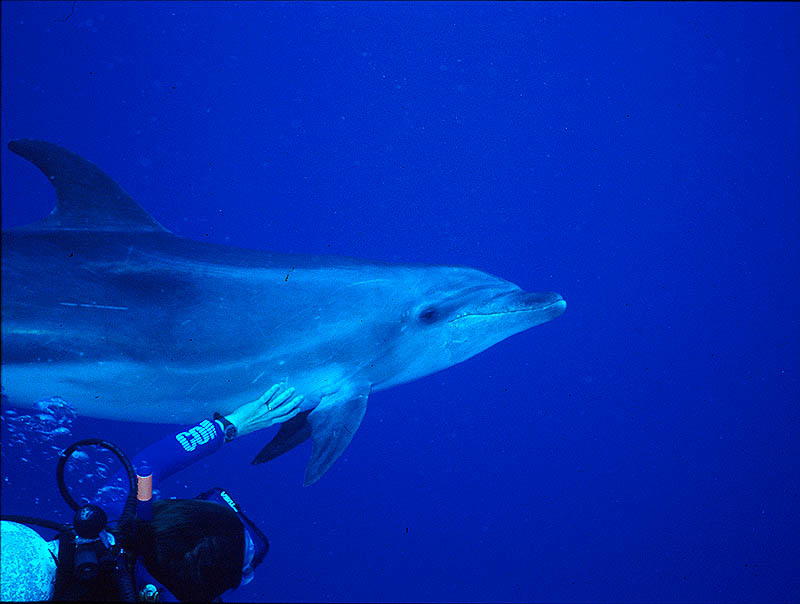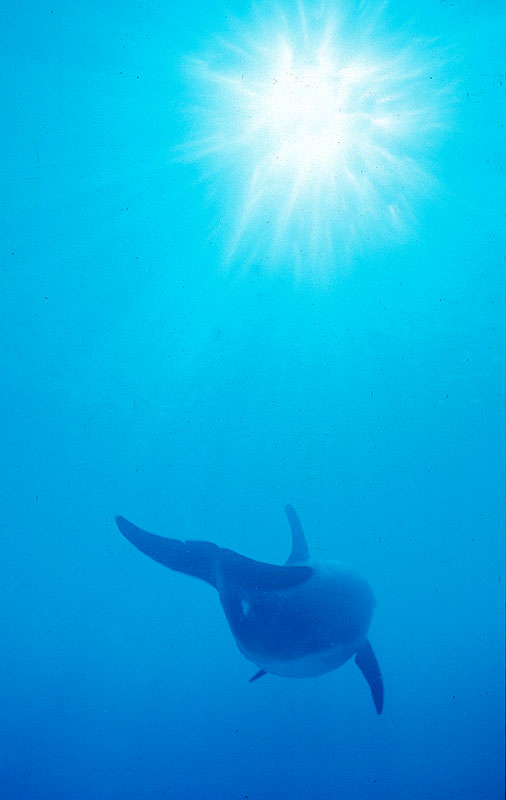


While we were visiting Cayman Brac, we got to swim with Spot, the Dolphin! Spot is a Bottlenosed Dolphin that likes people. This is unusual. Dolphins, especially Bottlenosed Dolphins, usually swim away when divers are in the water. But Spot swam with us as we dived, nudged us when we werenít paying enough attention to him, and actually begged us to pet him. These pictures show Spot as he swam with us.
Bottlenosed Dolphins are mammals. They are warm blooded, which means their bodies generate enough heat so they can live even in cold water. They breathe air, just like we do. That means they have to swim to the surface to breathe. Bottlenosed Dolphins have single blowholes in the tops of their heads through which they breathe. A dolphin swims to the surface, sticks the top of its head out of the water, opens the blowhole (which is a hole about the size of a quarter), and then exhales and inhales once. A single breath will allow a Bottlenosed Dolphin to stay underwater for many minutes.
It is unusual for Bottlenosed Dolphins to swim with divers. Divers are constantly blowing a stream of bubbles out of their scuba gear, and scientists think these bubbles scare the dolphins. The reason they think this is that wild dolphins travel in extended families, called pods. A pod has as many as 20 male and female dolphins. Whales also are mammals that travel in pods, and are closely related to dolphins. When a pod of whales meets another male whale in the water, the males from the pod will swim between the stranger and the podís females, and will blow bubbles from their blowholes underwater to try to hide the females from the stranger. Dolphin pods may do the same thing. So, when a dolphin sees all those bubbles, it may feel like it is not welcome and swim away.
Spot is different. He obviously likes people, and doesnít swim away from scuba divers. Why might this be?
The divemasters on Cayman Brac swim with Spot nearly every day. They think that Spot is a wild dolphin that used to live in captivity. Hurricane Mitch was a fierce storm that hit the country of Honduras in Central America in 1998. During this storm, a research facility that held several Bottlenosed Dolphins in captivity was damaged. Several of the dolphins escaped. The divemasters on Cayman Brac think that Spot was one of those dolphins. That makes sense. Those dolphins would have been used to people, and might have grown to want contact with humans, especially if they had been captured when they were very young. That may be why Spot, now a wild dolphin, seeks the company of humans in the water. If that is where Spot came from, he would have had to swim nearly 400 miles. Dolphins can swim that far. (The divemasters gave Spot his name, maybe because of a small white spot near his tail.)

The second picture shows Tessa Dowell touching Spot. Spot would sometimes close his eyes and roll over on his back when you touched him, especially if you scratched under his chin. Spotís skin was smooth, soft, and rubbery.
Spot likes to have fun. We watched him racing with our boat, swimming just under the surface near the bow. Spot used the wave on the bow to push him through the water, just like a surfer riding a surfboard on a wave. I also watched Spot chase a small fish as it swam across the sand between two areas of the reef. Spot would nudge it and open his mouth like he was going to bite it, but it was obvious that he was just playing with it. Another time, I was swimming near the sand to try to get close to a Great Barracuda so I could take its picture. I was concentrating so hard that I didnít see Spot swim up behind me. I heard a sound like a duck quacking, and when I turned around there was Spot wanting me to pet him. Tessa said that he even bit at my fins when my back was turned, because I wasnít paying attention to him. On another dive, Tessa was snorkeling with Spot at the surface. When she dove under water a few feet, Spot got very excited. He swam right beside her, then raced to the surface and jumped out of the water.

In this picture, notice how the tips of Spotís tail fin point from side to side. This is a difference between underwater mammals and fish. Fish have tail fins with tips that point up and down. Compare Spotís tail fin with the fins of some of the fish on the ReefNews website.
Spot was about 5 feet long. He was an adolescent male, which may be why he was alone and not yet living in a pod.
- Compare this Atlantic Bottlenosed Dolphin to the Atlantic Spotted Dolphin.
- Meet Tessa Dowell, ReefNews photographer, at: http://www.reefnews.com/reefnews/staff/tessa.html.
- Spot liked to be scratched. And Spot canít scratch himself, having no hands and not being able to bend enough to reach his belly with his snout. If a dolphinís skin is itchy, how do you think wild dolphins would be able to get scratched? Would traveling in a pod be any help?
This story first appeared in the e-ReefNews e-mail newsletter, Volume 1 number 14.
To subscribe to this free newsletter, check out the e-ReefNews subscription page.
You can order the entire e-ReefNews Volume 1 on CD-ROM, from the ReefNews Online Catalog.
Dr. Jonathan Dowell took this picture using a Nikonos V with 28mm lens.